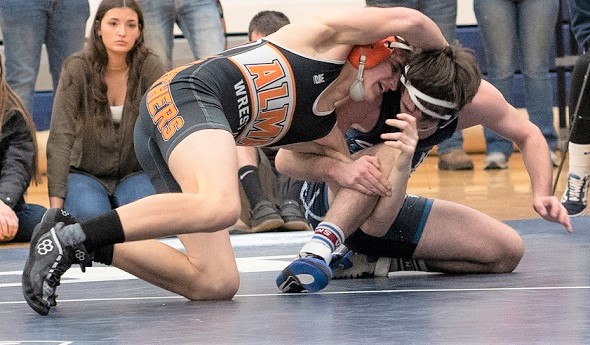
D3 Preview: Great Stories to be Told
By
Geoff Kimmerly
MHSAA.com senior editor
February 27, 2020
This weekend’s Division 3 story is familiar. But last year’s finish no doubt has added to the buildup.
Dundee or Richmond has won the last 10 Division 3 team wrestling championships, and they’ve faced each other in the deciding match eight of those 10 seasons. And for the third time in five seasons, last year’s title came down to the day’s final match – this time with Dundee earning the victory by the score of 26-25.
Those headliners are the top-two seeded teams again at Wings Event Center in Kalamazoo, but hardly the only story in Division 3. Among others, Fremont and Kingsley are in Quarterfinals for the first time, and Alma has made a big jump over the last two years to fall in alongside the favorites at the top.
The Division 3 Quarterfinals will be wrestled at 4:30 p.m. Friday. Top seed Dundee will wrestle Dowagiac, No. 2 Richmond will take on Kingsley, No. 3 Alma will face Fremont and No. 4 Montrose will match up with Remus Chippewa Hills. Semifinals are noon Saturday, with the championship match that afternoon at 3:45 p.m. All matches this weekend will be viewable live on a subscription basis on MHSAA.tv. For Friday’s schedule and results throughout, check the MHSAA Wrestling page.
Below is a look at all eight teams competing in Division 3, listed by seed.
#1 Dundee
Record/rank: 20-1, No. 1
League finish: First in Lenawee County Athletic Association
Coach: Tim Roberts, 21st season (535-75-1)
Championship history: Eleven MHSAA championships (most recent 2019), seven runner-up finishes.
Individual Finals qualifiers: 103 Braeden Davis (31-4) fr., 112 Kaden Chinavare (27-8) fr., 119 Jacob Fenbert (21-12) fr., 125 Aiden Davis (36-4) fr., 130 Austin Fietz (34-6) jr., 135 Casey Swiderski (32-1) soph., 135 Christian Killion (39-6) sr., 140 Kyle Yuhas (21-9) sr., 145 Tyler Swiderski (40-3) jr., 152 Dominick Lomazzo (17-4) jr., 160 Stoney Buell (38-3) jr., 181 Jaxon Guinn (31-8) sr., 215 Dennis Root (33-6) sr.
Outlook: Dundee has won two straight Division 3 titles and five of the last season, and this team remains built for now and the future with only four seniors among 13 Individual Finals qualifiers. After again winning an LCAA that included Division 4 top seed Hudson, Dundee gave up a combined 15 points over four District and Regional matches on the way back to Kalamazoo. Buell will be seeking his third individual championship next weekend, while Casey Swiderski will be seeking his second straight and Tyler Swiderski and Killion are both two-time Finals runners-up. Fietz and Guinn also are both repeat Finals placers.
#2 Richmond
Record/rank: 24-5, No. 2
League finish: First in Blue Water Area Conference
Co-coaches: Brandon Day, 16th season (476-98); Preston Treend, fourth season (94-14)
Championship history: Eight MHSAA championships (most recent 2017), seven runner-up finishes.
Individual Finals qualifiers: 103 Emmet Kettle (26-8) jr., 103 Noah Harris (23-8) fr., 112 Hunter Keller (32-3) jr., 119 JD Gross (27-12) sr., 119 Josh Barton (24-8) sr., 130 Austin Kilburn (16-3) sr., 145 Kevin McKiernan (20-15) soph., 171 Wesley Peters (30-9) soph., 189 Noah Montanari (29-3) sr., 215 Luke Davis (35-2) sr., 285 Dan McKiernan (28-5) jr.
Outlook: Richmond is the two-time reigning runner-up and like Dundee always finds its way into the championship mix. After emerging with another BWAC title, the Blue Devils defeated three of league foes and also Madison Heights Bishop Foley soundly over the last two weeks, giving up a combined 48 points over four postseason matches. Keller and Davis were Finals runners-up last season, while Kilburn and Peters were placers too and Gross and Dan McKiernan also will be returning to Ford Field after competing there a year ago.
#3 Alma
Record/rank: 24-2, No. 3
League finish: First in Tri-Valley Conference East
Coach: Randy Miniard, ninth season (212-95)
Championship history: Has not appeared in an MHSAA Final.
Individual Finals qualifiers: 119 Gianni Tripp (33-13) fr., 130 Solomon Rosales (37-9) jr., 135 Dametrius Castillo (33-7) jr., 140 Jarrett Ferman (25-5) sr., 152 Jacob Munger (28-12) soph., 160 Justin VanBlaricum (30-5) sr.
Outlook: The Panthers have made another jump, from the sixth seed last season to third this weekend as they return to the Quarterfinals for the third straight year. Alma’s road again took it through Lake Odessa Lakewood, and the Panthers doubled up the No. 5 Vikings 47-21 to win the Regional title. Rosales, Castillo, Ferman and VanBlaricum all were Finals qualifiers last season, as was sophomore Josiah Baltierra (125/31-14). Castillo was an individual champion in 2018, and he, Ferman and VanBlaricum all placed a year ago. Senior Carlos Espinoza (171/30-11) gives Alma another 30-match winner.
#4 Montrose
Record/rank: 32-3, No. 4
League finish: Second in Mid-Michigan Activities Conference
Coach: Steve Barnette, eighth season (172-79)
Championship history: Nine MHSAA championships (most recent 2005), five runner-up finishes.
Individual Finals qualifiers: 112 Seth Coffin (30-19) soph., 125 Aidan Bernard (45-4) soph., 152 Robert Skinner (28-6) jr., 171 Cody Smith (29-16) soph., 215 Levi Harber (44-4) soph.
Outlook: After last season ending a 13-year hiatus from the final weekend, Montrose is back for the second straight after wins over No. 8 Birch Run and No. 10 Otisville-LakeVille at the Regional. The lineup continues to be young and promising with only two senior starters but eight sophomores and a freshman in the expected lineup. Skinner was a Finals qualifier last season and senior Griffin Barnette (285/34-7) placed although he fell just shy of qualifying for Ford Field this season.
#5 Remus Chippewa Hills
Record/rank: 24-5, No. 6
League finish: First in Central State Activities Association
Coach: Kevin Edwards, second season (52-7)
Championship history: Division 3 runner-up 2016.
Individual Finals qualifiers: 103 Robert VanVleet (30-16) soph., 119 Gavin Miller (27-7) jr., 119 Taylor Gibson (32-14) sr., 125 Ozaawa Manito (24-17) sr., 130 Carson Hayes (32-8) jr., 171 Gabe Petoskey (28-18) sr., 189 Chayton Wiggins (35-8) sr., 215 Colby Roosa (33-4) jr.
Outlook: Make it nine straight Regional titles for Chippewa Hills as they look to also make the Semifinals for the sixth-straight season. The Warriors edged No. 9 Shepherd 37-31 in the Regional Final to advance this time. Hayes and Roosa are returning Individual Finals placers, and bolstering those above is junior Carl Whipple (215/33-10), a Finals qualifier in 2019 and one of five 30-match winners this winter.
#6 Fremont
Record/rank: 24-4, No. 7
League finish: Second in Central State Activities Association
Co-coaches: Craig Zeerip, sixth season (129-60)
Championship history: Has not competed in an MHSAA Final.
Individual Finals qualifiers: 103 RJ Thome (44-3) soph., 152 Trey Breuker (40-8) jr., 189 Michael Romero (33-15) fr., 215 Kyler Kolk (39-8) sr.
Outlook: The former Fremont and Ohio State wrestler and Hesperia head coach Zeerip will bring his alma mater to the Quarterfinals for the first time. After coming in second in the league to Chippewa Hills, Fremont edged Howard City Tri County 39-37 in its District Semifinal – but has doubled up all of its opponents since. Eight starters have won at least 30 matches, with seniors Matthew Halasinkski (140/38-10) and Chase Knudsen (160/36-9) among those joining Finals qualifiers listed above.
#7 Kingsley
Record/rank: 25-3, unranked
League finish: Second in Mid-Michigan Wrestling Conference
Coach: Corey Crew, first season (25-3)
Championship history: Has not appeared in an MHSAA Final.
Individual Finals qualifiers: 112 Justin Grahn (40-7) fr., 135 Aidan Shier (36-5) soph., 145 Kyan Fessenden (31-20) fr.
Outlook: In his first season leading the program, Crew has guided Kingsley to its first Regional championship and Quarterfinals trip. Eleven of 13 starters (while giving up 152) have winning records, and eight have at least 30 wins – and the team is nearly all underclassmen, with one senior and one junior on the roster. Sophomore Kaden Patterson (160/40-12), while falling shy of making the Individual Finals, also has topped 40 wins.
#8 Dowagiac
Record/rank: 23-9, unranked
League finish: Second in Wolverine Conference
Coach: Colin Burandt, fifth season (99-45)
Championship history: Two runner-up finishes (most recent 1998).
Individual Finals qualifiers: 103 Jordan Simpson (41-7) soph., 160 Lamberto Parades (35-12) sr., 215 Chris Schultz (19-12) sr., 285 Wyatt Bailey (40-8) jr.
Outlook: Dowagiac will bring double the number of Individual Finals qualifiers to Kalamazoo this weekend as it did a year ago as the program continues to build under former Niles standout Burandt. This team has six senior starters, as opposed to just two a year ago, and Bailey was an Individual Finals placer coming in eighth at 285 in 2019.
PHOTO: Alma, here against Lakewood in the Regional Final, will attempt to reach its first MHSAA team championship match this weekend. (Click for more from HighSchoolSportsScene.com.)

Old 5-A League Fueled Wrestling's Rise
June 29, 2020
By Ron Pesch
Special for Second Half
This latest quest into wrestling began with an inquiry, as these projects often do.
My work with the MHSAA – which includes the title ‘historian’ – is mostly a hobby that began many years ago. The diversion often gets me into press boxes and places the average sports fan doesn’t usually get to venture. Now and then, I get to talk into a microphone. But mostly, it is hours of digging; pouring through scrapbooks, yearbooks and newspapers, old and new, as I search for names, details and stories lost in time. The pursuit sometimes leads to awkward phone calls, e-mails and messages where I try to describe who I am and why I’m chasing a phone number for someone, a person’s mother or father, grandmother or grandfather.
I adore the chase and resolving mysteries. I love visiting libraries and schools and delight in connecting with people. I love filling in holes and connecting dots. I’m a computer guy by trade, focused on analyzing and aligning data. I equate sports searches to detective work, and for fans of old television, I’m like Columbo without the trench coat or cigar, always asking, “Just one more thing …”
Wrestling
My first visit to the sport was in junior high gym class. That’s when Coach Murphy paired me up against another undersized classmate. With the shrill of a whistle, we battled it out on a deep red colored mat – representative of one half of the red and grey school colors of Nelson Junior High. The struggle lasted for no more than a matter of seconds. With a slap of a mat, or perhaps another whistle, it was over. I lost by ‘fall’ – the gentler way of saying I was pinned.
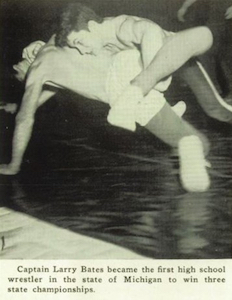 My second visit to the sport came in high school. That’s when the wrestling coach stopped me in the hall one day to suggest I join the wrestling team. Apparently, word of the skills I demonstrated at Nelson hadn’t travelled the half mile east from the junior high to the high school. Quickly recognizing this fact, I told him it might be counter-productive, as I wasn’t much of a wrestler. He was undeterred. Because I was still undersized, he said, I would likely win a fair number of matches. Many schools, it seemed, struggled to find someone to wrestle in the lower classes, and hence, would have to forfeit. I still turned him down.
My second visit to the sport came in high school. That’s when the wrestling coach stopped me in the hall one day to suggest I join the wrestling team. Apparently, word of the skills I demonstrated at Nelson hadn’t travelled the half mile east from the junior high to the high school. Quickly recognizing this fact, I told him it might be counter-productive, as I wasn’t much of a wrestler. He was undeterred. Because I was still undersized, he said, I would likely win a fair number of matches. Many schools, it seemed, struggled to find someone to wrestle in the lower classes, and hence, would have to forfeit. I still turned him down.
I give credit to the Coach Erickson. He was trying to involve a kid in athletics that wasn’t going to make the football, basketball or track team. But that bit of wisdom didn’t hit me until long after high school.
As the above may demonstrate, an extensive understanding of the intricate particulars of wrestling isn’t my strong suit. I’ve attended only one MHSAA Wrestling Final. That visit still remains among my favorite sports sights. The pageantry of the Grand March staged before the orchestrated pandemonium of the MHSAA wrestling championship combined with huge crowds and inspiring athleticism creates a spectacular event.
The Latest Project
Recently, a question, relating to past individual champions from the earliest days of the championships, arrived at the MHSAA office. The Association has awarded wrestling titles since 1948, and a list of team champions and runners-up from the beginning to the present appear on the MHSAA Website. Missing, however, are the names of the individuals who won championships between 1948 and 1960.
To find an answer, that meant a deep dive into newspapers, yearbooks and old wrestling guides to exhume the particulars from articles and agate, cross-referencing results, matching last names to first names, correcting spellings and occasionally schools when obvious errors have been made.
Technology has helped carve away some time and travel when embarking on such a project. Once, the only way to dig out such information was to travel to microfilm, and then spend hours scrolling past print. Today, thanks to some online archives, even during a global pandemic, we can visit a handful of Michigan newspapers via the internet. Tack on the ability to search the online cloud of information, intriguing elements intermittently bubble to the surface, transforming a standing list of names and schools to an account that brings at least some names to life.
The Beginnings
An initial look at the existing team championship listings revealed the first fact. For all intents and purposes, the earliest days of the MHSAA wrestling state championships served as a glorified meet for the members of the 5-A Conference. The league, comprised of Ann Arbor, Battle Creek Central, Jackson, Lansing Eastern and Lansing Sexton high schools, was where wrestling as a prep sport first gained traction in Michigan. Almost immediately, Greater Lansing established a stronghold on the sport that would last those first 13 years.
From 1948 to 1960, there was only one classification in which all schools, regardless of size, competed. In 10 of those 13 years, one of two Lansing high schools – Eastern or Sexton – won the state’s mat championship. In the three years when a Lansing team didn’t win, they finished as runner-up. Those three were part seven total of that baker’s dozen when either Eastern or Sexton finished second.
Growth in Michigan
The first championship tournament in 1948 involved around a dozen schools. While expansion into other schools commenced slowly, by 1957, wrestling had progressed into the fastest growing sport in Michigan.
“The sport blossoms into many new schools every year,” stated George Maskin in a January issue of the Detroit Times in 1957. “Best estimates are that at least 60 varsity prep teams now are in competition. The figure should come close to the 100 mark within a year or two. Prep wrestling has grown with such swiftness it now is necessary to hold regionals to determine qualifiers for the state meet.
“It is not the kind of wrestling one has watched on television or in some of the professional arenas around the state,” he added, trying to educate the public about the difference between the prep sport and the form of broadcast entertainment then popular. “Groans and grunts have no part in high school wrestling … nor does hair pulling or stamping the feet … or pointing a finger into the referee’s eye.”
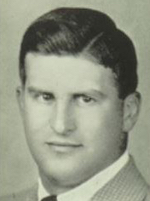 Coaches of wrestling noted that it was one of the few sports offered that gave equal opportunity to students regardless of their physical build. Separated into 12 weight classifications, running from 95 pounds and under up to the unlimited, or heavyweight division, there was a place for all.
Coaches of wrestling noted that it was one of the few sports offered that gave equal opportunity to students regardless of their physical build. Separated into 12 weight classifications, running from 95 pounds and under up to the unlimited, or heavyweight division, there was a place for all.
“Take the kid who weighs 95 pounds,” Ignatius ‘Iggy’ Konrad, a former wrestler at Michigan State and the coach at Lansing Sexton, told Maskin. “He’ll participate against a boy of similar weight. Thus a kid whose athletic possibilities might appear hopeless (in other sports) finds a place for himself in wrestling.”
As the sport continued to expand, coaches were still trying to explain the worth.
“Parents should try to understand the difference between television wrestling and high school and college wrestling,” Grandville coach Kay Hutsell told a Grand Rapids Press reporter in December 1960. “There is no comparison. TV is 100 percent acting.”
A state champion wrestler as a high school student in Illinois, where spectator interest and participation was far greater than in those early days of wrestling in Michigan, Hutsell twice lettered in the sport at Indiana University.
“Wrestling is a conditioner and perhaps develops the body better than any other sport. About the only way wrestling can educate the adults (in the western Michigan area about the sport) is through newspapers.” He felt people should come to “see for themselves.”
The Tournament
Lansing Sexton won the state’s inaugural team wrestling title, 54-43 over the Ann Arbor Pioneers, with the event run off on the mats of the University of Michigan in 1948. Both Floyd Eaton at 127 pounds and Carl Covert at 133 ended the year undefeated for the Big Reds. Five wrestlers from each school earned individual titles that first year. Jackson’s heavyweight, Norm Blank, scored a pin over Sexton’s Dick Buckmaster. The pair had split their two previous matches during league competition.
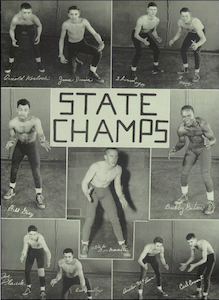 Ann Arbor grabbed the next two MHSAA team titles, both by a mere four points, first 60-56 over Sexton, then topping the Quakers of Lansing Eastern, 56-52, in 1950.
Ann Arbor grabbed the next two MHSAA team titles, both by a mere four points, first 60-56 over Sexton, then topping the Quakers of Lansing Eastern, 56-52, in 1950.
Eight wrestlers qualified for the final round for both Ann Arbor and Sexton in 1949, with five each earning championships. Both schools had three wrestlers finish in third and fourth place; hence the team title was awarded based on Ann Arbor tallying more pins. A total of 96 wrestlers from 11 schools participated in the tournament. Ted Lennox, wrestling at 95 pounds, became the first athlete from the Michigan School for the Blind to compete for an individual title but was defeated by Sexton’s Leo Kosloski. Lennox would later wrestle for Michigan State.
In 1950, nine Ann Arbor wrestlers advanced to the final round with six seizing championship medals, but only Sam Holloway repeated as champion from the previous year. Teammate Jack Townsley, who had won in 1949 at 112 pounds, finished second at 120.
 Eastern and coach Don Johnson grabbed the first of two consecutive titles in 1951, topping Ann Arbor, 56-52, with East Lansing finishing a distant third with 26 points. Pete Christ of Battle Creek Central became the first Bearcat (and only the second athlete from a school other than Eastern, Sexton or Ann Arbor) to bring home an individual wrestling title, with a decision over Lansing Eastern’s Vince Malcongi in the 140 classification. “The Bearcat matmen took fourth in the State,” according to the Battle Creek yearbook. “Mr. Donald Cooper took over the coaching duties when Mr. Allen Bush was called to the Marines.” (Bush would later serve as executive director of the MHSAA).
Eastern and coach Don Johnson grabbed the first of two consecutive titles in 1951, topping Ann Arbor, 56-52, with East Lansing finishing a distant third with 26 points. Pete Christ of Battle Creek Central became the first Bearcat (and only the second athlete from a school other than Eastern, Sexton or Ann Arbor) to bring home an individual wrestling title, with a decision over Lansing Eastern’s Vince Malcongi in the 140 classification. “The Bearcat matmen took fourth in the State,” according to the Battle Creek yearbook. “Mr. Donald Cooper took over the coaching duties when Mr. Allen Bush was called to the Marines.” (Bush would later serve as executive director of the MHSAA).
Johnson’s squad absolutely dominated the field in 1952, topping Sexton the next year, 68-43. Ann Arbor followed with 39 points. Seven Quakers – George Smith (95), Herb Austin (103), Jim Sinadinos (127) Bob Ovenhouse (133), Bob Ballard (138), Ed Cary (145) and Norm Thomas (175) – all won their final matches. Both Austin and Sinadinos were repeat champions.
Sexton flipped the table in 1953 with a 67-46 win over Eastern. Ten Big Reds competed for individual state championships among the 12 classifications, with five taking home titles. The Big Reds’ Ken Maidlow, jumping from 165 pounds to 175, and Eastern’s Ed Cary, who moved up to 154, both repeated as medal winners. In the heavyweight class, Sexton’s Ray Reglin downed Steve Zervas from Hazel Park. (Zervas, a two-time runner-up, later wrestled at the University of Michigan, then coached wrestling at Warren Fitzgerald for 34 seasons and served as mayor of Hazel Park from 1974 to 1986).
In 1954, Ossie Elliott of Ypsilanti and Henry Henson of Berkley became the first wrestlers from non 5-A schools to win individual state wrestling titles. Elliott, who had finished as state runner-up in 1953 at 133 pounds, downed Lansing Sexton’s Tom Holden in the same classification. Henson earned a decision over Lansing Eastern’s Ken Bliesener at 154 pounds. Eastern again returned to the winner’s circle, outdistancing Sexton, 60-44. Ypsilanti finished third with 34 points.
By 1955, athletes from 28 high school teams were battling for state team and individual honors on the mats at MSC’s Jenison Field House. As a senior captain, Lansing Eastern’s Larry Bates pinned four out of five opponents in the 112-pound class to become Michigan’s first wrestler to earn three state crowns. Bates grabbed his first title in 1953, competing at 95 pounds, followed by his second in 1954 at 103. Eastern picked up its second-straight team trophy, racking up 102 points on the way to a fourth crown in the eighth year of championships. For the first time, a non-5-A school finished second, as the Ypsilanti Braves grabbed runner-up honors with 84 points.
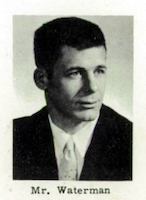 Coach Bert Waterman led Ypsilanti to the first of four championships during a 10-year span in 1956. Two Braves, Ambi Wilbanks and Walt Pipps, earned titles while three others finished second in their classifications. Ypsi had lost one dual meet during the regular season, to Lansing Eastern, by a slim three-point margin. With the 1967-68 school year, Waterman would embark on a 24-year career as coach at Yale University after posting a 192-35-4 mark in 16 seasons at Ypsilanti. A 1950 graduate of Michigan State, the former Spartans wrestler would join Eastern’s Don Johnson, Sexton’s Iggy Konrad, Fran Hetherington from the School for the Blind and two other high school coaches as a charter member of the Michigan Wrestling Hall of Fame in November 1978.
Coach Bert Waterman led Ypsilanti to the first of four championships during a 10-year span in 1956. Two Braves, Ambi Wilbanks and Walt Pipps, earned titles while three others finished second in their classifications. Ypsi had lost one dual meet during the regular season, to Lansing Eastern, by a slim three-point margin. With the 1967-68 school year, Waterman would embark on a 24-year career as coach at Yale University after posting a 192-35-4 mark in 16 seasons at Ypsilanti. A 1950 graduate of Michigan State, the former Spartans wrestler would join Eastern’s Don Johnson, Sexton’s Iggy Konrad, Fran Hetherington from the School for the Blind and two other high school coaches as a charter member of the Michigan Wrestling Hall of Fame in November 1978.
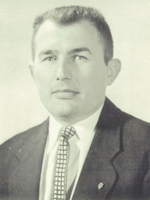 Runner-up in 1956, Eastern grabbed another title in 1957 topping Battle Creek Central, 93-89, in the tournament standings. It was a surprise “going away present” for Coach Don Johnson, who was stepping away after 10 seasons of coaching the Quakers to accept the assistant principal position at Eastern. Battle Creek had five wrestlers advance, and held a 56-48 lead over Eastern as the teams entered the final round. The Quakers’ Ted Hartman opened the day with a victory in the 98-pound weight class, helping Eastern post a 3-1 record in championship round matches. Sexton assisted with the Eastern victory when Norm Young defeated Battle Creek’s Bob McClenney in the 120 weight class. The Bearcats, who had five wrestlers in the finals, ended with two individual champs on the day and their highest finish in their 10 seasons of wrestling.
Runner-up in 1956, Eastern grabbed another title in 1957 topping Battle Creek Central, 93-89, in the tournament standings. It was a surprise “going away present” for Coach Don Johnson, who was stepping away after 10 seasons of coaching the Quakers to accept the assistant principal position at Eastern. Battle Creek had five wrestlers advance, and held a 56-48 lead over Eastern as the teams entered the final round. The Quakers’ Ted Hartman opened the day with a victory in the 98-pound weight class, helping Eastern post a 3-1 record in championship round matches. Sexton assisted with the Eastern victory when Norm Young defeated Battle Creek’s Bob McClenney in the 120 weight class. The Bearcats, who had five wrestlers in the finals, ended with two individual champs on the day and their highest finish in their 10 seasons of wrestling.
An All-American wrestler at Michigan State, Johnson would remain at Eastern throughout his education career, retiring as principal in 1983. The fieldhouse at Eastern was named after him in December 1984, fittingly just prior to the championship round of the annual Eastern High Wrestling Invitational.
Eastern again went back-to-back, topping Sexton, 88-57, with Ypsilanti third in the 1958 championship standings. The meet, culminating with 16 boys competing in each weight division – four each from regionals hosted at Battle Creek, Lansing, Ypsilanti and Berkley – was held at the Intramural Building at the University of Michigan. Both Eastern and Sexton advanced four wrestlers to the final round, with Eastern’s Gary Gogarn (95), Ron Parkinson (145) and Alex Valcanoff (154) earning titles. For Sexton, Fritz Kellerman (133) and Wilkie Hopkins (138) finished on top.
The 1959 championships, hosted at the new intramural building at MSU, found boys from 47 schools chasing medal honors.
“Points toward the team title are awarded one for each bout won, with an extra point for a fall,” noted the Lansing State Journal, explaining the mechanics of the tournament. “The big scoring chance comes (in the final round) with a first place netting 10 points, second 7, third 4 and fourth 2.”
Jackson and Sexton had tied for the 6-A Conference crown (the league renamed with the addition of Kalamazoo Central to the mix) and the race to the MHSAA title was expected to be a tight one. Jackson qualified seven for the semifinal round, with four advancing to the championships. The Big Reds sent five wrestlers to the last round. Vikings Ron Shavers (95), Nate Haehnle (145) and Don Mains (165) had each won matches, while Sexton’s qualifiers Tom Mulder (127) and Emerson Boles (175) had earned titles.
With one match remaining, Jackson trailed Iggy Konrad’s Big Reds by four, 67-63, as the Vikings’ Ed Youngs – the state’s reigning heavyweight champion – squared off with Sexton’s Mickey Devoe. Youngs grabbed a 3-1 decision to repeat, but the Vikings needed a fall in the match for a tie. Hence, the Big Reds eked out a single-point victory, 74-73, to escape with their third state mat title.
The results of the title round of the 1960 tournament, also won by Sexton, telegraphed how far the sport had come. Wrestlers from a dozen high schools squared off for honors in the title matches, with winners representing 10 cities. The Big Reds topped Ypsilanti 70-64, followed by Kalamazoo Central with 56 points. Eight other schools had scored at least 20 points in the tournament; 31 teams had scored at least a point. Tom Mulder of Sexton was the lone repeat champion.
With 112 schools now offering wrestling on their sports menu, the MHSAA split the event into two parts for the 1959-60 school year, with Class A set for the University of Michigan and Class B hosted by Michigan State University. The sport was now in full bloom.
 Ron Pesch has taken an active role in researching the history of MHSAA events since 1985 and began writing for MHSAA Finals programs in 1986, adding additional features and "flashbacks" in 1992. He inherited the title of MHSAA historian from the late Dick Kishpaugh following the 1993-94 school year, and resides in Muskegon. Contact him at [email protected] with ideas for historical articles.
Ron Pesch has taken an active role in researching the history of MHSAA events since 1985 and began writing for MHSAA Finals programs in 1986, adding additional features and "flashbacks" in 1992. He inherited the title of MHSAA historian from the late Dick Kishpaugh following the 1993-94 school year, and resides in Muskegon. Contact him at [email protected] with ideas for historical articles.
PHOTOS: (Top and 4) Lansing Sexton won the first MHSAA Finals in wrestling in 1948. (2) Eastern’s Larry Bates became the first three-time individual champion in MHSAA history in 1955. (3) The Big Reds were led by coach Ignatius Konrad. (5) Lansing Eastern kept the championship in the capital city in 1949. (6) Bert Waterman built one of the state’s top programs at Ypsilanti. (7) Don Johnson was the architect of Eastern’s program.(Photos gathered by Ron Pesch.)

